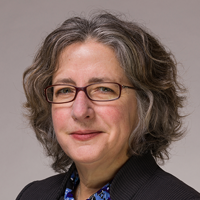
Teaching in WGS
Teaching at UNL is always a lot of fun. Teaching classes in WGS especially so. Probably my favorite course is WMNS 4/802 (History of Sexuality in 19th and 20th Century America). Guided by two themes—the history of same-sex relationships and the history of fertility control—this course tackles current hot-button issues through a historical lens. At first, students are surprised to discover that this history bears little resemblance to nostalgic “such things didn’t happen in my day” renditions of the past. We read old love letters, birth control advertisements, medical case histories, and court transcripts. We watch old movies and contemporary historical documentaries. We even read comic books. This is all done with the goal of understanding the richness of people’s lives (in good times and bad) as they were buffeted about by larger historical forces. As my students will regularly attest, I’ll do whatever it takes to make real the stories of “just another dead person from the past,” even if it means inviting them to read aloud from a bunch of old texts.
However, as we dig deeper into these stories, my students say they gain a new awareness about the complexity of contemporary issues surrounding sexuality, one that not only affords new ways to think about these subjects but also new ways to talk about them. This too is a central goal of this class. Indeed, while my classroom fosters creative curiosity, it also offers a much-needed haven for dialog and listening across the ideological spectrum on issues deeply important to us all—in the past and the present.
Research in WGS
In broadest strokes, my research investigates the history of women, medicine, and sexuality; it is also driven by my desire to provide new ways to engage in conversations about reproductive politics. To that end, my most recent project investigates the little known but hugely influential Dickinson-Belskie Birth Series sculptures, which depict the process of human in utero development from fertilization through delivery. Created in the late 1930s, the Birth Series first went on display at the 1939-1940 World’s Fair in New York City. Hugely popular, the sculptures were then reproduced in a variety of forms and sent out to medical teaching institutions, health museums, and major philanthropic organizations across the US and the globe. Significantly, within this story lies an unexpected tale about the ways in which art and religion can affect the scientific knowledge we create about our bodies—and how we interpret it. Moreover, it provides a strikingly productive way to engage in conversations about pregnancy and the abortion debate.
WGS Courses
WMNS/HIST 402 & 802: Sexuality in 19th & 20th Century America
WMNS 489: Senior Seminar
WMNS 485 & 885: Feminist Theories, Feminists’ Perspectives
WMNS 301 (Sexuality and Power): Pregnancy in Medicine, Law, and Society - Past & Present
Publications
Book
The Birth Control Clinic in a Marketplace World (University of Rochester Press, 2012). URP’s Medical History Series.
Articles
“The 1939 Dickinson-Belskie Birth Series Sculptures: The Rise of Modern Visions of Pregnancy, the Roots of Modern Pro-Life Imagery, and Dr. Dickinson’s Religious Case for Abortion,” Journal of Social History 51:4 (June 2018): 980-1022.
“Nurse Gordon on Trial: Those Early Days of the Birth Control Clinic Movement Reconsidered,” Journal of Social History 39:1 (Fall 2005): 112-140.
Book Chapters/Essays
"Biological Bodies, Unfettered Imaginations: The 1939 Dickinson-Belskie Birth Series Sculptures and the Unexpected Origins of Modern Anti-Abortion Imagery,” in Rethinking the Public Fetus: Historical Perspectives on the Visual Culture of Pregnancy, edited by Elisabet Björklund & Solveig Jülich (University of Rochester Press, 2024).
“‘Art in the Service of Medical Education:’ The 1939 Dickinson-Belskie Birth Series and the Use of Sculpture to Teach the Process of Human Development from Fertilization Through Delivery,” in Visualizing the Body in Art, Anatomy, and Medicine Since 1800: Models and Modeling, edited by Andrew Graciano (Routledge, 2019).
“Why the Classroom is a Sacred Place for Me and Why I'll Keep Venturing Out Into ‘No-Man’s Land’...Even During these Abortion Wars,” The American Historian (February 2017).
Selected Awards/Accomplishments
Hazel R. McClymont Distinguished Teaching Fellow Award, College of Arts and Sciences, UNL, 2019.
Faculty Fellow on Student Success, Executive Vice Chancellor’s Office, UNL, 2018-2019.
Francis A. Countway Library Fellow in the History of Medicine, Boston, MA, 2015-16.
Distinguished Teaching Award, College of Arts and Sciences, UNL, 2012.
Interviews
Deann Gayman, “Holz continues research into early pioneer of prenatal medicine," Nebraska Today, March 25, 2024.
Stephanie Gorton, "At the 1939 World's Fair, Robert Latou Dickinson Demystified Pregnancy for a Curious Public," Smithsonian Magazine, July 24, 2023.
Deann Gayman, “Precious and rare: Research unearths sculptures long forgotten,” Nebraska Today, October 25, 2019.
Emma Kopplin, “UNL Professor Leads Judgment-Free Discussions on Abortion,” Daily Nebraskan, February 1, 2019.
Sarah Mirk, “In Bizarre 1976 Comic Book, Spider-Man Fought the Villain of Misleading Sex Education,” Bitch, April 23, 2014.